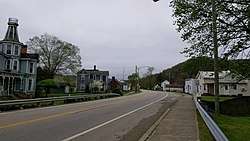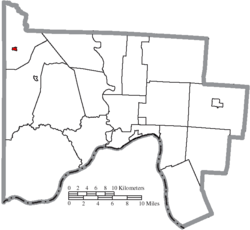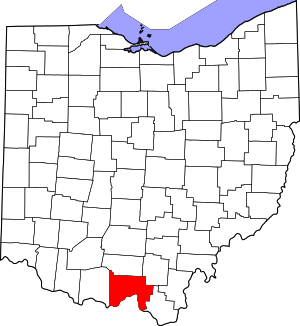Rarden, Ohio
Rarden is a village in Scioto County, Ohio, United States. The population was 159 at the 2010 census.[6] It was originally called "Moccasin" by early Pennsylvania settlers, and it originated in 1846.[7] Orvil Grant (1835-1881), brother of Ulysses S. Grant, was an early settler of the town and named it Galena after the Grants' family home in Galena, Illinois. The village was incorporated in 1886 and renamed in honor of an early settler, Thomas Rarden.[8][9]
Rarden, Ohio | |
|---|---|
 West Main Street of Rarden, Ohio. | |
 Location of Rarden, Ohio | |
 Location of Rarden in Scioto County | |
| Coordinates: 38°55′24″N 83°14′32″W | |
| Country | United States |
| State | Ohio |
| County | Scioto |
| Government | |
| • Type | Village |
| • Mayor | Ronald Syroney |
| • Fire Chief | Roger McAllister |
| Area | |
| • Total | 0.21 sq mi (0.55 km2) |
| • Land | 0.21 sq mi (0.55 km2) |
| • Water | 0.00 sq mi (0.00 km2) |
| Elevation | 620 ft (189 m) |
| Population | |
| • Total | 159 |
| • Estimate (2019)[4] | 147 |
| • Density | 693.40/sq mi (268.27/km2) |
| Time zone | UTC-5 (Eastern (EST)) |
| • Summer (DST) | UTC-4 (EDT) |
| ZIP code | 45671 |
| Area code(s) | 740 |
| FIPS code | 39-65508[5] |
| GNIS feature ID | 1061585[2] |
Geography
Rarden is located at 38°55′24″N 83°14′32″W (38.923254, -83.242248).[10]
According to the United States Census Bureau, the village has a total area of 0.21 square miles (0.54 km2), all land.[11]
Demographics
| Historical population | |||
|---|---|---|---|
| Census | Pop. | %± | |
| 1890 | 296 | — | |
| 1900 | 443 | 49.7% | |
| 1910 | 350 | −21.0% | |
| 1920 | 302 | −13.7% | |
| 1930 | 303 | 0.3% | |
| 1940 | 306 | 1.0% | |
| 1950 | 251 | −18.0% | |
| 1960 | 250 | −0.4% | |
| 1970 | 232 | −7.2% | |
| 1980 | 199 | −14.2% | |
| 1990 | 184 | −7.5% | |
| 2000 | 176 | −4.3% | |
| 2010 | 159 | −9.7% | |
| Est. 2019 | 147 | [4] | −7.5% |
| U.S. Decennial Census[12] | |||
2010 census
As of the census[3] of 2010, there were 159 people, 67 households, and 46 families living in the village. The population density was 757.1 inhabitants per square mile (292.3/km2). There were 82 housing units at an average density of 390.5 per square mile (150.8/km2). The racial makeup of the village was 99.4% White and 0.6% Asian.
There were 67 households, of which 29.9% had children under the age of 18 living with them, 49.3% were married couples living together, 10.4% had a female householder with no husband present, 9.0% had a male householder with no wife present, and 31.3% were non-families. 28.4% of all households were made up of individuals, and 13.5% had someone living alone who was 65 years of age or older. The average household size was 2.37 and the average family size was 2.87.
The median age in the village was 42.5 years. 23.9% of residents were under the age of 18; 6.8% were between the ages of 18 and 24; 23.9% were from 25 to 44; 28.3% were from 45 to 64; and 17% were 65 years of age or older. The gender makeup of the village was 46.5% male and 53.5% female.
2000 census
As of the census[5] of 2000, there were 176 people, 69 households, and 48 families living in the village. The population density was 860.8 people per square mile (339.8/km2). There were 82 housing units at an average density of 401.1 per square mile (158.3/km2). The racial makeup of the village was 93.18% White, 3.41% Native American, 0.57% from other races, and 2.84% from two or more races.
There were 69 households, out of which 34.8% had children under the age of 18 living with them, 52.2% were married couples living together, 15.9% had a female householder with no husband present, and 30.4% were non-families. 26.1% of all households were made up of individuals, and 14.5% had someone living alone who was 65 years of age or older. The average household size was 2.55 and the average family size was 3.15.
In the village, the population was spread out, with 24.4% under the age of 18, 8.5% from 18 to 24, 35.2% from 25 to 44, 14.8% from 45 to 64, and 17.0% who were 65 years of age or older. The median age was 36 years. For every 100 females there were 102.3 males. For every 100 females age 18 and over, there were 104.6 males.
The median income for a household in the village was $35,781, and the median income for a family was $36,250. Males had a median income of $30,000 versus $28,500 for females. The per capita income for the village was $13,247. About 1.6% of families and 1.2% of the population were below the poverty line, including none of those under the age of eighteen and 2.8% of those 65 or over.
References
- "2019 U.S. Gazetteer Files". United States Census Bureau. Retrieved July 28, 2020.
- "US Board on Geographic Names". United States Geological Survey. 2007-10-25. Retrieved 2008-01-31.
- "U.S. Census website". United States Census Bureau. Retrieved 2013-01-06.
- "Population and Housing Unit Estimates". United States Census Bureau. May 24, 2020. Retrieved May 27, 2020.
- "U.S. Census website". United States Census Bureau. Retrieved 2008-01-31.
- "Profile of General Population and Housing Characteristics: 2010 Demographic Profile Data (DP-1): Rarden village, Ohio". United States Census Bureau. Retrieved March 29, 2012.
- "Portsmouth Area Resource Guide, 2007-2008". The Community Common. 2007-07-29. p. 7.
- Overman, William Daniel (1958). Ohio Town Names. Akron, OH: Atlantic Press. p. 116.
- Jim Detty, David E. Huffman, and Linda Arthur Jennings (2013). Postcard History Series: Scioto County. Arcadia Publishing. p. 67.CS1 maint: multiple names: authors list (link)
- "US Gazetteer files: 2010, 2000, and 1990". United States Census Bureau. 2011-02-12. Retrieved 2011-04-23.
- "US Gazetteer files 2010". United States Census Bureau. Archived from the original on 2012-01-25. Retrieved 2013-01-06.
- "Census of Population and Housing". Census.gov. Retrieved June 4, 2015.
